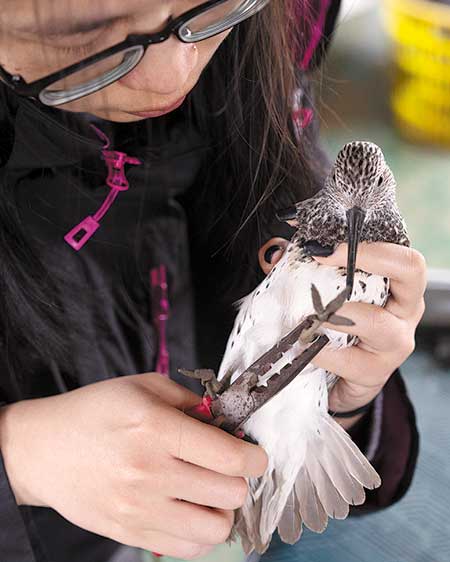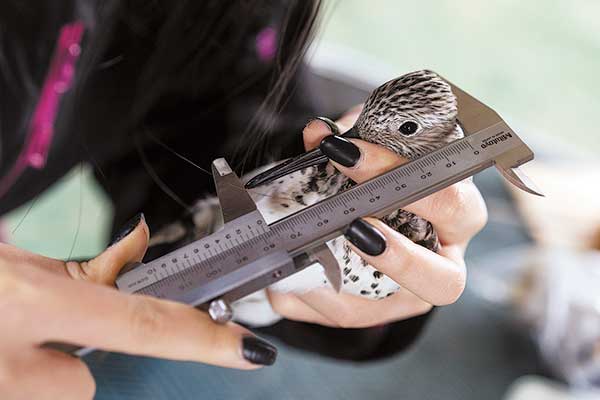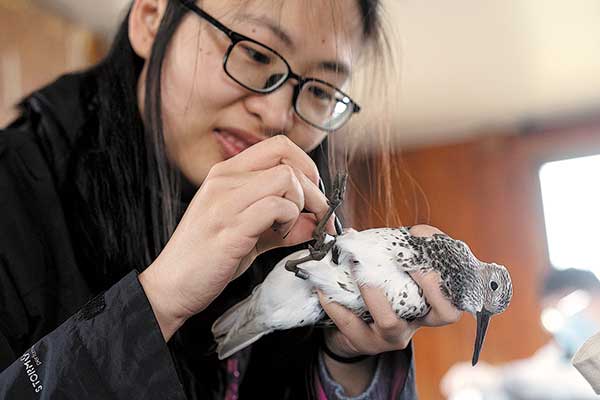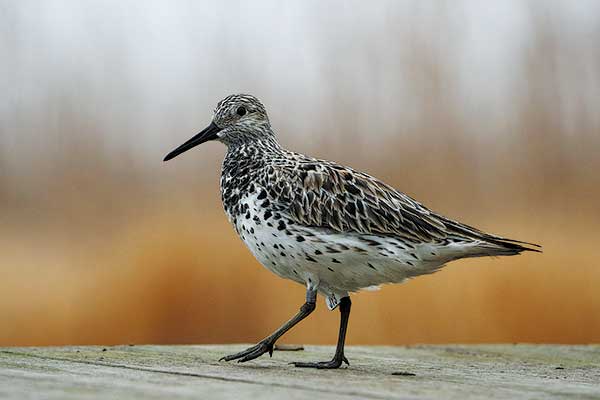今日上海
向复苏的飞跃 - 2024年05月06日
The flight to recovery

Birds fly freely at the Chongming Dongtan National Nature Reserve in Shanghai late in March.
As the spring arrives, migratory birds are heading to their annual breeding grounds. The Chongming Dongtan National Nature Reserve in Shanghai, which is located in the middle of the East Asian-Australasian Flyway, is a major stopover point for migratory waterbirds making the long journey.
These wetlands on the eastern coast of Chongming Island are also home to the reserve's staff and research teams from Fudan University, who are busy banding birds, a decades-long task that involves attaching identification tags to the birds to track them and their routes.
"About 1 million visits by migratory birds — including those that fly past as well as stop over — are recorded at Dongtan every year," says Ma Zhijun, in his early 50s, a professor at Fudan University's School of Life Sciences, adding that an increasing number of waterbirds have been observed.
"We have been working together for more than 20 years. Through bird banding, we can better monitor the birds and carry out in-depth research on migration, getting to know more about them, conserving them, and protecting the whole ecosystem," Ma adds.
Zhao Yexi, 22, a doctoral student at Fudan University, says that bird banding involves fitting a small ring and a colored leg flag to a bird's leg. The ring is stamped or engraved with a unique code, and each colored flag represents a specific region.
The bands are usually loose enough to turn around the leg but not so loose they slip past the ankle. In addition, the banding process also involves identifying and recording each bird's basic information, such as species, age, sex, as well as morphological measurements of the length of wings and weight. The banding data is linked to the bird with its identification number. It is then registered on a database, and shared around the world for use in large-scale, long-term studies to track migratory movements, population dynamics, life span and behavior.
Newer technology also permits placing a positioning tracker on select birds, which allows researchers to precisely track the bird's continental, hemisphere-wide or even global movements.
"Bird banding is a common and effective means of monitoring the movement of birds, charting their migratory patterns, and supporting conservation," Zhao says.
"Over the past 20 years, more than 50,000 birds have been banded at the Chongming Dongtan reserve," Ma adds. "We are able to collect firsthand data and study their migratory routes, major stopover sites and timings. The data also helps us gain in-depth understanding, as well as new understanding of the natural history of migratory birds, and their link to the environment."

An Siwei, a Fudan University alumna who works at the reserve, measures a great knot bird to gather information for banding, a decadeslong task that involves attaching identification tags to the birds to track them and their routes.
In the middle
The annual routes migratory birds traverse are known as "flyways". There are nine major flyways around the world, including the East Asian-Australasian Flyway, which stretches from Alaska and the Russian Far East, southward through East and Southeast Asia, to Australia and New Zealand. It encompasses 22 countries and regions.
The flyway is used by more than 50 million birds and over 250 species, including 36 that are globally threatened and 19 that are near-threatened, according to the East Asian-Australasian Flyway Partnership, a network of partners across the EAAF that protects migratory birds.
Normally, birds migrate twice a year. In the fall, they fly south to winter, and in spring, they head back north to breed. In the middle of this flyway, and listed by the Ramsar Convention as a Wetland of International Importance, the Chongming Dongtan reserve is a critical stopover site. The convention is an international treaty that came into force in 1975.
"Many birds fly more than 10,000 kilometers in a single trip between breeding and wintering grounds. Generally, they cannot finish the entire journey in one go, and have to stop over along the way to rest and refuel. Many shorebirds are very dependent on mudflats bordering the sea, like Dongtan," Ma says.
In the past few decades, coastal mudflats have undergone sharp decline as a result of reclamation and excessive exploitation for urbanization and economic development, which has resulted in a rapid decrease in many waterbird populations as a consequence of the loss of habitats.
Fortunately in recent years, China has placed increasing emphasis on environmental protection, introducing a slew of regulations and policies to protect wetlands and bird habitats, as well as to promote ecological restoration.

An Siwei, a Fudan University alumna who works at the reserve, measures a great knot bird to gather information for banding, a decadeslong task that involves attaching identification tags to the birds to track them and their routes.
Established in 1998, the reserve has made great strides in enhancing the conservation of birds and the wetland ecosystem. The task has not been easy. One of the biggest challenges the reserve has faced is controlling cordgrass, an invasive alien plant.
According to Wu Wei, senior engineer at the reserve, cordgrass began expanding rapidly across the Dongtan mudflats in 2002. It chokes out the native plants on which birds depend for survival, posing a serious threat to the ecosystem.
Between 2012 and 2018, the reserve carried out a large-scale management project on invasive plant control and ecological restoration following a series of experiments and attempts. With measures such as the construction of ecological berms and the creation of bird habitats, it managed to exterminate over 95 percent of the cordgrass, which has led to the steady recovery of native plants like reeds and the sea bulrush.
"At the moment, we see that the results of the project have turned out quite well. Our bird monitoring results also show an obvious recovery and increase in the population of waterbirds here," Wu says.
One example that proves the success of the project is the notable rise in the population of tundra swans.
"The total population monitored in Dongtan in the 1990s was 3,000 to 3,500. In 2000, the species saw a sharp decline. The implementation of the project helped swans regain food and habitats, and we saw their population recover rapidly. We monitored nearly 3,000 tundra swans during the recent wintering season," Ma says, adding that many birds are choosing Dongtan as their summer breeding ground as its improved ecology provides an ideal habitat. This includes the Saunders's gull, a national first-class protected bird.
"Saunders's gulls used to breed on the Liaohe River estuary in northeastern China. But now we are monitoring around 100 of them breeding at the reserve every year. The overall population is estimated to be in excess of 10,000, up from 3,000 or 5,000 two decades ago," Ma adds.

An Siwei, a Fudan University alumna who works at the reserve, measures a great knot bird to gather information for banding, a decadeslong task that involves attaching identification tags to the birds to track them and their routes.
Agreements
The conservation of migratory birds is never the task of an isolated reserve, but requires joint efforts by different parties around the region, the country and the world. Given the long distances, international cooperation along the flyway is essential to conserving and protecting migratory birds and their habitats.
"The protection of a single site is never enough for conservation. The success of certain bird conservation projects is usually the result of joint efforts made by many countries," Ma says.
China has become more involved in international cooperation around migratory bird conservation since the 1980s. The National Bird Banding Center of China, part of the Chinese Academy of Forestry, was established in 1982. It functions as a national authority that compiles bird data collected across the country, to be shared internationally for conservation and research purposes.
The country has signed bilateral conservation agreements with others under the East Asian-Australasian Flyway, including Japan, Australia, South Korea and Russia, and there is more frequent international communication and exchange among academies and scientific research institutions, with visiting students and researchers taking part in bird banding, fieldwork and monitoring.
The Yangtze River Delta region has also been increasing conservation efforts in recent years, Ma says. Last winter, Shanghai, and Jiangsu, Anhui and Zhejiang provinces joined forces to carry out a survey of wintering waterbirds, according to Ma.
"The Yangtze River Delta region is geographically connected and has plentiful wetland resources, so we are able to contribute jointly to waterbird conservation. Although different species may use different places in the region, we still see much commonality. With the country's increasing emphasis on the environment and protecting biodiversity and support from regional governments, we are expecting more coordinated conservation efforts for birds, habitats and wetlands," Ma says.

The bird, great knot, is set free after bird banding.
Popular engagement
Bird conservation is not far removed from the public sphere. Everyone can play a part.
In recent years, bird-watching has gained more popularity in China and some birdwatchers are already playing a role in conservation. Qiu Xiaohua is one of them.
The 50-year-old engineer works in Shanghai and commutes weekly to his home in Hangzhou, Zhejiang. He has been a birdwatcher for more than 10 years and can identify more than 500 species.
Qiu says that for him, and for many others, a typical bird-watching experience includes different aspects, such as observation, identification, taking photos or videos, recording bird calls, as well as recording the time and place at which each bird is spotted. Finally, all this information is uploaded and shared via websites, data centers and social media platforms.
The amount of data collected by one individual may seem small, but when the data generated by a large number of bird-watchers is added together, it can make a big difference.
"Actually, bird-watchers now contribute to many new bird distribution records. Our research team is small and the scope of our surveys is narrow," Ma says. "However, thousands of bird-watchers nationwide are collecting data, which can result in a large-scale database supporting research in various fields, such as bird distribution, movement patterns and population dynamics."

A black-faced spoonbill rests at the reserve.
Both Ma and Qiu agree that the number of bird-watchers in Shanghai is growing, owing to economic development, improving living standards and the rising environmental consciousness among the public.
"Technological advancement has also lowered the threshold for involvement. Instead of reading books to learn about birds, newcomers now can rely on a mobile app or WeChat mini-program to identify and record them. This has made it much easier for people to start bird-watching and feel the sense of achievement that comes from it," Qiu adds.
In addition, there are other things people can do to help conserve birds and their habitats.
"First of all, we would like to call on the public to reduce the use of disposable products, especially plastic ones," Wu says.
Ma also advises the public to reduce activities that disturb birds and let them live in as near a natural state as possible. The provision of green areas in cities also needs consideration to provide birds with more food and suitable habitats, which will enhance biodiversity and environmental harmony.

Gao Qianhua (holding equipment) and their mentor Jin Weiguo catch birds at the reserve for banding and identification.

Yin Hongchao catch birds at the reserve for banding and identification.

Yin Hongchao catch birds at the reserve for banding and identification.
Source: China Daily
